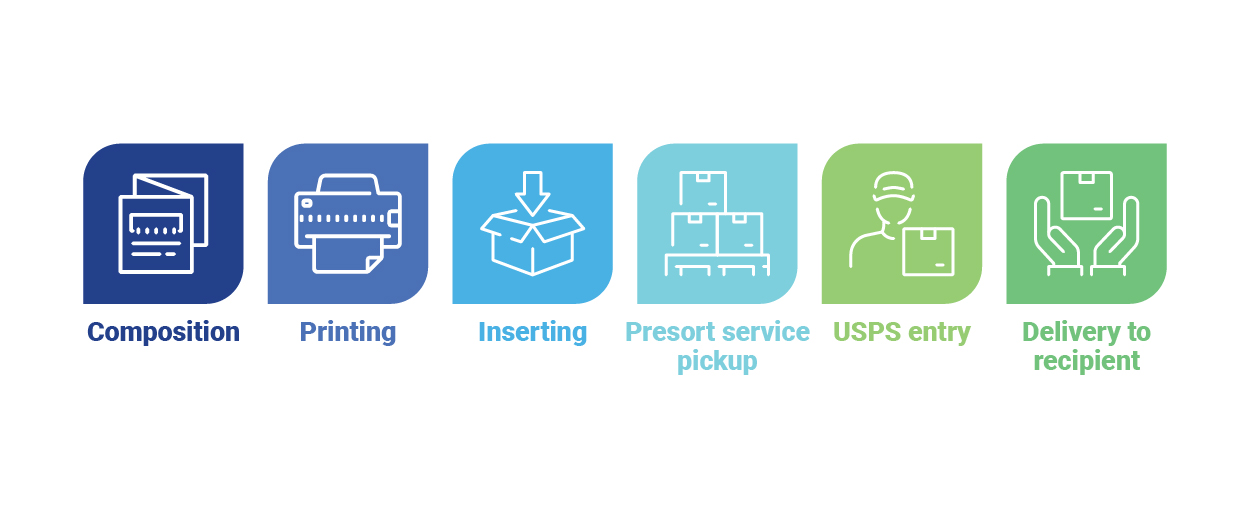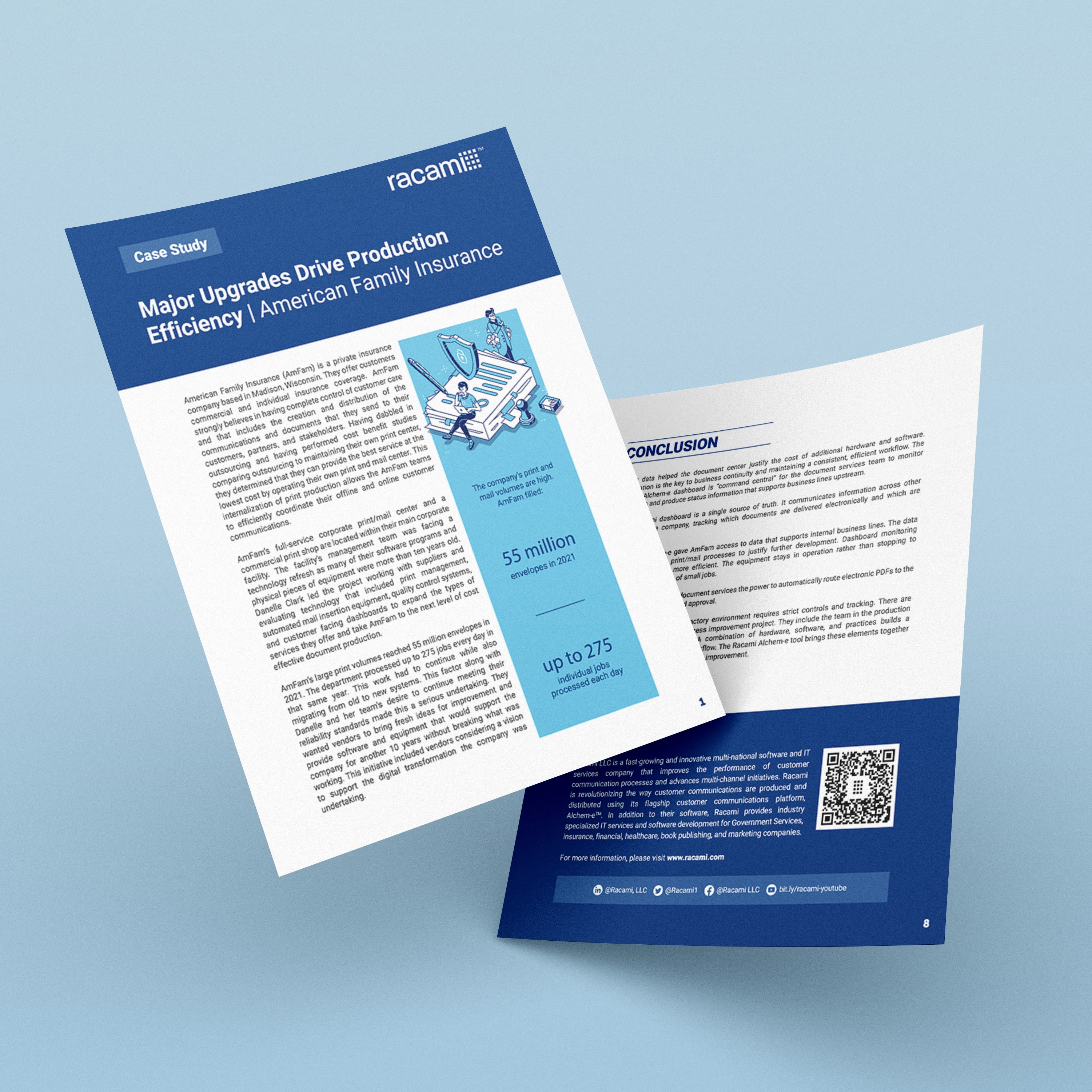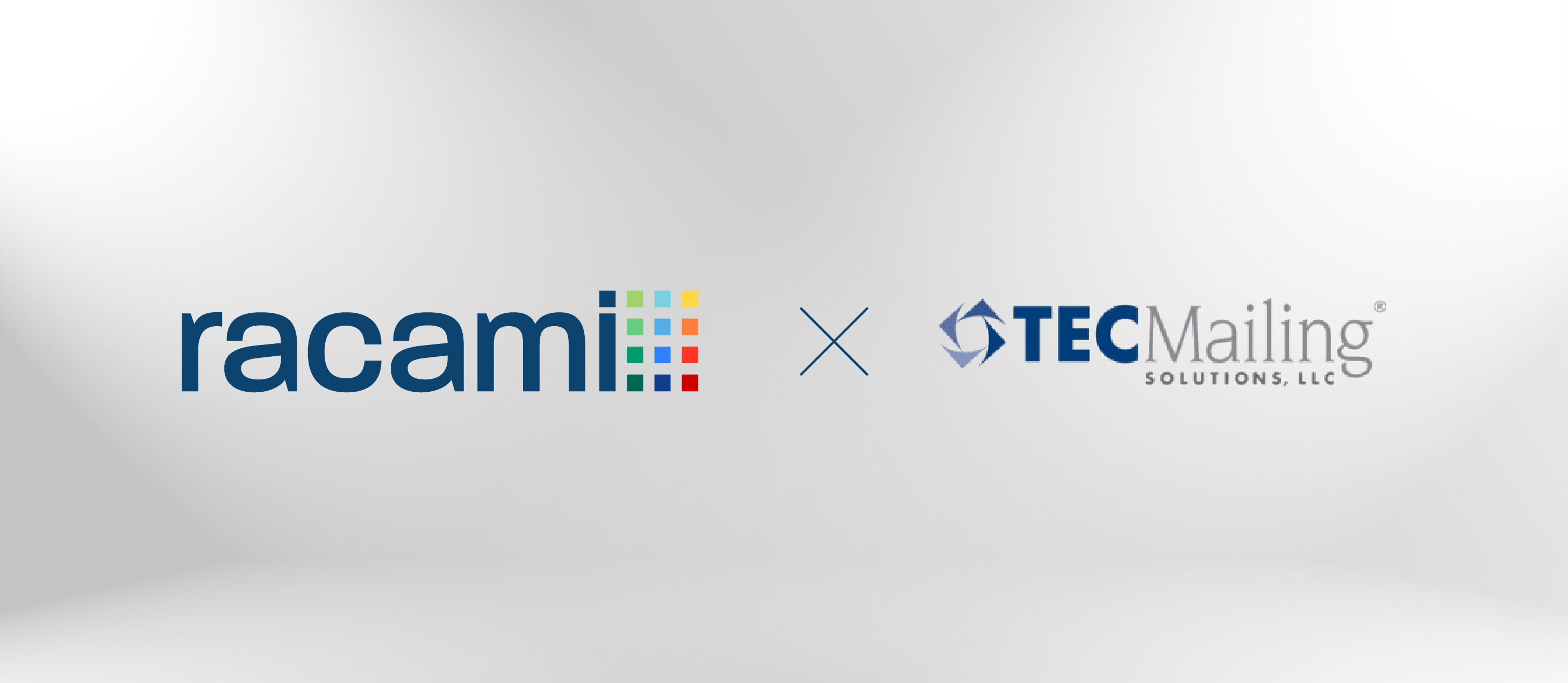American Family Insurance (AmFam) is a private insurance company based in Madison, Wisconsin. They offer customers
commercial and individual insurance coverage. AmFam strongly believes in having complete control of customer care and that includes the creation and distribution of th communications and documents that they send to their customers, partners, and stakeholders. Having dabbled in outsourcing and having performed cost benefit studies comparing outsourcing to maintaining their own print center, they determined that they can provide the best service at the lowest cost by operating their own print and mail center. This internalization of print production allows the AmFam teams to efficiently coordinate their offline and online customer communications.
AmFam’s full-service corporate print/mail center and a commercial print shop are located within their main corporate facility. The facility’s management team was facing a technology refresh as many of their software programs and physical pieces of equipment were more than ten years old. Danelle Clark led the project working with suppliers and evaluating technology that included print management, automated mail insertion equipment, quality control systems, and customer facing dashboards to expand the types of services they offer and take AmFam to the next level of cost effective document production.
AmFam’s large print volumes reached 55 million envelopes in 2021. The department processed up to 275 jobs every day in that same year. This work had to continue while also migrating from old to new systems. This factor along with Danelle and her team’s desire to continue meeting their reliability standards made this a serious undertaking. They wanted vendors to bring fresh ideas for improvement and provide software and equipment that would support the company for another 10 years without breaking what was working. This initiative included vendors considering a vision to support the digital transformation the company was undertaking.
The company’s print and mail volumes are high. AmFam filled:
envelopes in 2021
individual jobs processed each day
THE SITUATION
- The department managed print data in many formats, including AFP, PostScript, and ASCII line data. Operations were constrained to route jobs to specific printers depending on the data streams, therefore, limiting their overall capacity.
- AmFam used Emtex FlexServer, a print management system designed for production operations. FlexServer’s sufficient, but it’s older user interface is less featured than newer print mangers, is not browser based which limits its use to print operators in production, and only holds job data for ten days rendering it useless for historical analysis, capacity planning, and providing evidence of what was produced.
- The Print and Mail Services team processed 275 jobs a day on 13 inserters. An abundance of small jobs resulted in frequent equipment stoppages and setups throughout the day, limiting the organization’s productivity.
- Business partners upstream often made document changes without consulting operations. The business units had little insight into how their changes would affect the document production workflow.
- The company had no ability to automatically track the progress of jobs and individual mail pieces, including time-sensitive materials like checks and policy cancellation notices.
- The organization used over 60 different pre-printed forms.
- Some inserters were set up for a specific job. The equipment sat idle for a good part of the time.
THE CHALLENGES
Aging technology – AmFam’s print manager, inserters, quality control systems, and management systems were all capable of supporting the output, but they were showing their age. This revealed itself in several ways such as running on platforms that were approaching security obsolescence, were not keeping up with the features available in newer tools, did not support modern integration techniques, and had thick clients and licensing models that constrained their use to IT and production staff, while business people could have benefitted from access to those systems.
Increase quality control of printing and inserting – Inserting machines were unreliable and finicky. Once setup to run specific jobs well, they were kept that way limiting the flexibility that would produce greater throughput and reduce delivery times.
Desire to reduce costs through additional automation – AmFam continually looks for ways to improve their operation and reduce costs. They wanted to make sure the products they purchased would deliver good ROI.
Provide better customer service to lines of business – Danelle’s team wanted to make it easier for their customers to access information that they could use to do their jobs better. AmFam’s line of business owners, customer care departments, security and compliance staff, and others could serve themselves on a portal day or night without having to call the central print center. This fast access to large amounts of information would
increase productivity and contribute to better decisions that affect AmFam’s customer satisfaction.
“In the old days before we upgraded, inserters were set up for a specific job—and ran nothing else. Everyone knew if a machine ran a job really well, they weren’t to touch it!”
— Danelle Clark, AmFam Enterprise Correspondence Technologies Manager
THE OBJECTIVE
AmFam Print and Mail Services wanted to improve the collection of production data, streamline access to document statuses, respond to business unit submissions and inquiries, and create evidence that every communication was produced accurately. They needed to provide easy access to reports, including a charge back mechanism to combine all associated costs for each department using enterprise printing services. The team required visibility of all touchpoints in the document process, including:

The department sought to reduce the number of pre-printed forms by using a white paper factory approach that allowed them to print the forms in line with the data. Furthermore, AmFam’s Print and Mail department wanted to replace their manual document reprint process with an automated solution.
IMPLEMENTATION
American Family Insurance Print and Mail Services used a three-phase approach to reach the desired state.
Phase One:
The first phase included a review of all the document operation’s equipment. They identified hardware they could eliminate or replace with more flexible machines from Bowe.
– AmFam reduced their inserter count from 13 machines to 5. Based on research and visits to other companies with similar printing operations, they upgraded to equipment that could easily change from flats to letter-size envelopes.
– Ms. Clark’s team recommended replacing their IBM 4100 continuous form printers with modern inkjet or toner printing presses better suited for modern white paper factory production.
Phase Two:
The second step was deciding about print stream formats. An initial effort to use print stream transformation software to change their legacy AFP print files into PDFs was eventually abandoned.
The company decided to re-compose most of their documents in PDF instead. They composed pages for approximately 600 jobs using an Open Text document composition tool.
Phase Three:
The third step was converting legacy pre-printed forms to the new system, implementing the whitepaper factory process, and developing the automated document production workflow under the control of Racami’s workflow automation platform.
– The platform would track each step in the process and provide reports. The system would make it possible to charge back all associated costs to the operating companies.
– Print room operators would use Alchem-e’s print manger to manage daily printing activity.
– Inserter control files (Bowe DBDI files) would be created by Alchem-e for file based insertion integrity and automated “touch and toss” reprinting.
– Adding the workflow dashboard software was part of an extensive overall technology upgrade.
THE RESULTS
American Family Insurance dramatically improved the print/mail process, access to data, and standardization of jobs. A combination of hardware, software tools, and collaboration from upstream business units contributed to the success. Measurable benefits include:
- Printed items are now tracked. The system gathers and reports information about when a document is printed, enters the mail stream, and is delivered.
- Inserter jobs are more efficient. The data the AmFam team collected from their production workflow dashboard allowed them to group jobs together for greater inserting productivity.
- Charge back reporting accumulates all associated charges and submits them to the business units.
- Charge back reporting accumulates all associated charges and submits them to the business units.
- Inserter operators no longer spend time trying to flatten and hand-insert documents damaged in a jam. They have transitioned to a “touch and toss” environment. With the workflow tool, AmFam sends a job to the inserter. The equipment provides a status report every few seconds. When a job is completed, the application closes the file. The system knows if mail pieces are missing.
- If reprints are necessary, the workflow dashboard generates a reprint file. AmFam has abandoned the former practice of manually processing single-item reprints, which was wasting time and causing mistakes.
- The department consolidated over 60 pre-printed forms into just five of them.
- The workflow automation tool provided easy access to data that allowed the document center team to respond to queries from their internal customers.
- AmFam is now tracking at a “roll” level rather and job, split, and mail- piece level. There are certain rolls for certain jobs, resulting in fewer changeovers and higher productivity.
- AmFam Print and Mail Services met 100% of their SLAs in 2021, even while battling the effects of the pandemic. The document center automation efforts contributed significantly to this effort.
“We got initial stakeholder buy-in for this large project based on the cost savings from eliminating all those pre-printed forms. Now that we’ve shown the benefits of a white paper workflow and comprehensive tracking and reporting, we can pursue other updates and improvements.”
— Danelle Clark, AmFam Enterprise Correspondence Technologies Manager
CONCLUSION
Better data helped the document center justify the cost of additional hardware and software. Automation is the key to business continuity and maintaining a consistent, efficient workflow. The Racami Alchem-e dashboard is “command central” for the document services team to monitor operations and produce status information that supports business lines upstream.
– The Racami dashboard is a single source of truth. It communicates information across other systems in the company, tracking which documents are delivered electronically and which are printed.
– Racami’s Alchem-e gave AmFam access to data that supports internal business lines. The data also helps fine-tune print/mail processes to justify further development. Dashboard monitoring makes inserting jobs more efficient. The equipment stays in operation rather than stopping to reconcile an abundance of small jobs.
– The Alchem-e tool gives document services the power to automatically route electronic PDFs to the business units for review and approval.
Progressing to a whitepaper factory environment requires strict controls and tracking. There are many players in a print/mail process improvement project. They include the team in the production area and customers upstream. A combination of hardware, software, and practices builds a successful white paper factory workflow. The Racami Alchem-e tool brings these elements together for a systematic approach to process improvement.




